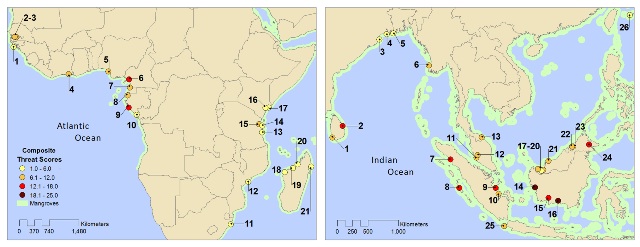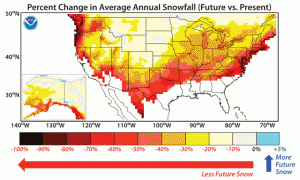
by Morgan Kelly, Office of Communications
Ecologists have evidence that some endangered primates and large cats faced with relentless human encroachment will seek sanctuary in the sultry thickets of mangrove and peat swamp forests. These harsh coastal biomes are characterized by thick vegetation — particularly clusters of salt-loving mangrove trees — and poor soil in the form of highly acidic peat, which is the waterlogged remains of partially decomposed leaves and wood. As such, swamp forests are among the few areas in many African and Asian countries that humans are relatively less interested in exploiting (though that is changing).
Yet conservationists have been slow to consider these tropical hideaways when keeping tabs on the distribution of threatened animals such as Sumatran orangutans and Javan leopards, according to a recent Princeton University study in the journal Folia Primatologica. To draw attention to peat and mangrove swamps as current — and possibly future — wildlife refuges, Katarzyna Nowak, a former postdoctoral researcher of ecology and evolutionary biology at Princeton, compiled a list of 60 primates and 20 felids (the large-cat family that includes tigers and leopards) known to divide their time between their natural forest habitats and some 47 swamp forests in Africa and Asia.
Because swamp forests often lack food sources, fresh water and easy mobility, few mammals are exclusive to these areas, Nowak reported. Consequently, conservation groups have not intensely monitored the animals’ swamp use.
But the presence of endangered cats and primates in swamp forests might be seriously overlooked, Nowak found. About 55 percent of Old World monkeys — primates such as baboons and macaques that are native to Africa and Asia — take to the swamps either regularly, seasonally or as needed. In 2008, the Wildlife Conservation Society reported that the inaccessible Lake Télé swamp forest in the Republic of the Congo was home to 125,000 lowland gorillas — more than were thought to exist in the wild. Among big cats, the Bengal tiger, for instance, holds its sole ground in Bangladesh in the Sundarbans, the world’s largest mangrove forest.

Life in the swamps can still be harsh for some animals. Species such as the crab-eating macaque and fishing cat can adapt somewhat readily to a life of swimming and foraging for crustaceans. Meanwhile, Zanzibar’s red colobus monkey — driven to coastal mangroves by deforestation — can struggle to find the freshwater it needs, as Nowak reported in the American Journal of Primatology in 2008. Such a trend could result in local extinction of the red colobus nonetheless, she said.
Nowak concludes that swamp forests beg further exploration as places where endangered species such as lowland gorillas and flat-headed cats have preserved their numbers — and where humans could potentially preserve them into the future.
Citation: Nowak, Katarzyna. 2013. Mangrove and Peat Swamp Forests: Refuge Habitats for Primates and Felids. Folia Primatologica. Vol. 83, no. 3-6, pp. 361-76.



You must be logged in to post a comment.